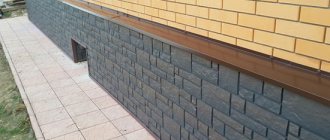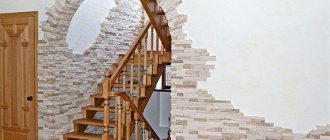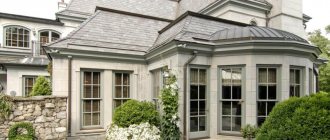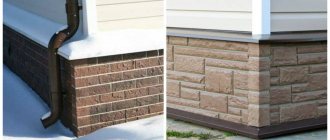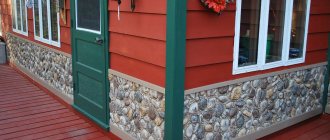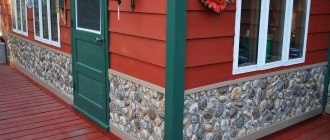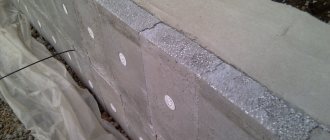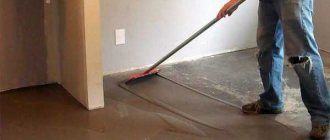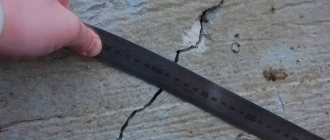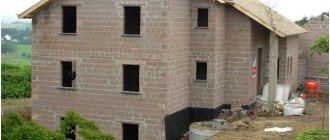Requirements for cladding material for the plinth
Kirill now has some free time. This time, as a future architect, he was interested in the materials and technology of cladding the plinth with artificial stone. He quite successfully made molds and gypsum-based stone for interior decoration in his workshop with his own hands. The production of finishing material for the facade is similar.
Artificial stone on the plinth
Only the components are different. According to the shape of the resulting surface - the relief of the base, artificial stone is divided:
- structural;
- raised;
- ragged;
- smooth.
From a cement-sand mixture, you make a flat stone for the facade without any forms with your own hands. Thin gypsum tiles are suitable only for interior decoration. Kirill knew the requirements for cladding the base and clearly explained it to me.
- High strength and hardness. The base is constantly subject to mechanical damage. This includes a toddler pushing a wall with his foot, a janitor's shovel clearing snow, and even the bumper of an incompetent driver's car.
- Moisture resistance. Rain not only falls on the walls, but splashes from puddles and melting snow and moisture from the ground are added to it.
- Frost and heat resistance. In winter and summer, the base is less protected from the cold wind and scorching sun than other parts of the facade.
- Eco-friendly. Facade cladding should not emit harmful substances.
Artificial decorative stone on the facade
- Fire resistance or otherwise fire safety. The material is completely non-flammable and can withstand high temperatures without decomposition.
- Decorative, aesthetic appearance. The base must match the style and image of the facade, emphasize and improve it.
To what the nephew has listed, it should be added that proper finishing of the base of the house with artificial stone significantly reduces heat loss in winter and creates comfort by removing dampness. Laying the foundation and decorating the facade is inexpensive. The man-made material is stronger and more resistant to water and ultraviolet radiation. In addition to natural tones, it can be painted in any color.
Decorating the facade of a house or cottage with artificial stone (video)
What is the material?
This is a decorative material used for cladding the lower part of a country house or residential building, industrial and commercial buildings. It protects against physical and climatic phenomena. Despite its origin, the coating reliably protects the base part from the penetration of water and cold.
The material has a number of advantages:
Availability, which is several times lower compared to natural analogues.- Easy installation thanks to lightweight design and processing capabilities.
- Variety of textures, textures and shades.
- Resistance to changes in humidity and temperature.
- Long service life.
- Significant fire safety.
- When heated, no harmful components are released.
- Environmental cleanliness and safety.
- You can easily keep the coating in order with standard detergents.
As a result, the material of artificial origin retains most of the advantages of natural coating. At the same time, its feature is an expanded selection. color variety and originality of the composition.
Types of cladding slabs and panels
Artificial decorative facing stone for plinths is available in different shapes, colors and sizes. It imitates any natural mineral. This is clearly visible in the photo. It can be divided into groups according to the material that forms its basis:
- cement;
- polymer;
- clay.
Separately, it is necessary to highlight the flexible stone that recently appeared on the construction market. It is distinguished by its light weight and plasticity. Panels are made from flexible artificial stone for the plinth based on fiberglass, and various adhesive compositions that hold stone chips on its surface. A cement-sand mixture with various additives is the hardest.
Finishing the base with artificial stone
Includes:
- Portland cement;
- sand;
- plasticizers;
- dyes;
- fillers;
- reinforcing additives.
Expanded clay, perlite or granite chips are used as fillers. Depending on this, the stone turns out lighter or harder. The mixture is poured into molds and imitates sandstone, tuff; limestone, dolomite and other natural stones. Polymer sand stone most often imitates cobblestone, dolomite, roughly processed, textured sandstone. It cannot be done in a home workshop because it requires complex equipment. Expanded clay, sand and crumbs are combined into tiles with a polymer under special conditions.
Finishing material: slabs and panels, made to resemble marble, granite, limestone, flat or with slight relief. The clay is formed under high pressure, annealed at temperatures above 1000 degrees, and covered with glaze to protect it from moisture and increase strength. The brick finish is made from individual tiles, which must be glued directly to the plaster. The panels are mounted on the frame, making insulation and siding.
Nuances of choosing decorative stone
When choosing a material, the following parameters are taken into account:
- Superb view.
- Compliance with installation technology.
- Functional and technological connection with blind areas, since when facing it is important to ensure normal moisture release and thermal insulation.
- Compliance with the architectural solution.
The material meets the parameters of environmental safety and environmental protection. There should be no chips, damage or cracks on the surface. The color of individual strips must match the rest.
Finishing and insulation technology
Facing the base with artificial stone
The video clearly shows in all details the technology of finishing the base and ebb with artificial stone. Individual decorative fragments are glued onto the plastered and prepared surface. Sheathing is made under the panels and slabs, just like under siding. Insulation and hydrobarrier are installed.
- The surface of the base is prepared, defects are cleaned, cracks and depressions are sealed.
- Depending on the material, everything is covered with a protective compound. Primed.
- Under the wet facade it is plastered and leveled. Lathing is made for siding.
- Insulation is being installed. Closed with a hydraulic barrier.
- Tiles imitating brick and imitating processed stone and cobblestone are attached using glue. The slabs and panels are mounted on the cladding.
When the cladding is completed, a blind area is made, and flashings are installed along the border between the wall and the foundation and below.
Design features of artificial stone plinth
When creating a design scheme for decorative finishing of a house, you should definitely pay attention to the fact that the external characteristics must be harmoniously combined with other finishing materials for the roof or facade as a whole. This refers to both shade and shape. The use of clear, even lines of artificial stone of the same shape will be the most acceptable solution if the structure is made of brick and some decorative elements of the facade echo the colors of the artificial material as well as its dimensions.
If the house is made of monolithic concrete, it is better to use an asymmetrical arrangement of large parts of the material over the entire surface of the base. At the same time, it is worth paying attention to the fact that imitation cladding with wild gray species goes well with any style trends, as well as modern finishing materials.
Finishing the plinth in 4 hands
Kirill and I had to finish the basement of a private brick house with artificial stone. To give the façade solidity, the ground floor must be tiled and insulated. The customer chose imitation hewn, unpolished limestone as the finishing material. It was cast from a cement-sand mixture and had a textured surface. Such stone must be laid on plaster or a smooth concrete slab.
We took a tool and metal spatulas and began to clean the base and the foundation that protruded in places. When one side of the facade was ready, we checked it for flatness, and I began to seal the cracks, knocking down a couple of protrusions. The nephew, having finished cutting, began to cover everything with primer.
How to decorate a base with artificial stone
Kirill already learned how to plaster and could make a smooth surface with a difference of up to 2 mm. Therefore, I entrusted him with leveling the walls for insulation. A few days later, when the plaster was completely dry, we coated it with a deep penetration primer in 2 layers with an interval of 6 hours. After this, we marked a horizontal line around the perimeter using a level and a cord. We attached the starting U-shaped profile according to the marks.
The basement floor was insulated with penoplex slabs. Brands 31C and 35 were suitable for us. We preferred the second one because it was more moisture resistant and suitable for the base and foundation. At the back the ground rose and the base was low. We cleaned up the foundation a bit to cover the wall. All we had to do was glue the insulation. Kirill spread the glue and smoothed it with a notched trowel. I inserted the first row of orange foam into the starting profile and pressed it tightly. The panels can be glued together so that there are no gaps - cold bridges.
Plaster does not adhere well to the smooth surface of the insulation. We secured the mesh and plastered the walls along it. Again I had to wait for it to dry completely. After this, we used the existing marking lines and began cladding. Rectangular bricks had different sizes. Kirill picked up and laid out everything on the ground, I carried and glued stone by stone onto the plinth. When the adhesive solution had dried, we painted the seams and coated the bottom of the façade with a protective compound and matte varnish.
Tools and Supplies
Before installation, you need to prepare materials and tools. For quality work you will need:
- trowel;
- mesh for reinforcement;
- concrete solution;
- adhesive composition;
- screwdriver;
- drill or hammer drill;
- composition for jointing;
- dowels;
- building level;
- deep penetration primer.
The exact composition depends on the installation method chosen. Sometimes you have to weld the frame. In other cases, you have to prepare an even coating and glue the prepared strips.
Wooden building
While working on the restoration of the old dacha, I again took Kirill as my assistant. As a future architect, he must see and feel in practice the aging of building materials and methods for their restoration. The wooden house had a weak foundation and it was impossible to overload it with finishing. The base was cleaned and impregnated with protective compounds. Then they installed the frame. The siding of a log house is usually made of wooden beams.
Foam plastic was laid between the slats and covered with film, protecting it from moisture. The siding was made from stone panels. Their installation is simple; they are attached to the sheathing and to each other using a tongue-and-groove connection and self-tapping screws to the beams. The cladding cost the customer little. The foundation turned out to be light and warm.
How to cover the basement floor of a private house with your own hands?
The stone of artificial origin is relatively light in weight. For this reason, installation is relatively simple. It is important to first clean the base from uneven surfaces, grease stains, and dirt. It is advisable to align the base element with a deviation of up to 15 mm. If the base is relatively flat, an adhesive composition is used for fastening.
To do this, perform the following steps:
- The base is covered with deep penetration soil.
- Then the notches are made.
- Special glue is applied.
- Attach strips or panels.
This method is suitable for flexible stone or material with low density. In this case, it is important not to apply glue to the entire surface at once, as it dries quickly. It is enough to prepare the stone in advance and cover no more than 1 square meter with glue. m. covering.
Large tiles, such as polymer sand stone, are attached to the frame . It has grooves to tightly connect the tiles to each other. First, a metal or wooden sheathing is installed. After this, fastening with dowels is possible.
Photo gallery of finished works
Why is plinth cladding necessary?
Many owners of private houses and cottages consider the external cladding of the basement only as an element of exterior decoration, trying to make it more beautiful and refined. The desire is quite understandable - the beautiful decoration of the lower part of the building gives the entire structure a qualitatively new look, makes it distinguishable from other houses, and shows the artistic taste of the owners.
Cladding the base of the house with natural stone
However, it should be remembered that the main tasks of cladding include:
1. Protection of the base of the building from ultraviolet radiation, weathering, sudden temperature changes, high humidity, direct sunlight (leading to heating)
Cladding the base will protect the house from moisture
2. Counteraction to various pollution. The lower part of the house is almost always exposed to dust and dirt, all kinds of chemically active substances that cause erosion even in the most resistant concrete
Lining the plinth will prevent concrete erosion
3. Protection from possible penetration of fungus and mold, other biological life that can cause significant harm to the building and the health of people living in it.
The cladding will prevent mold from penetrating
4. The ability to pre-insulate the base, preventing cold from entering the lower rooms through the concrete
House basement insulation scheme
Based on the foregoing, we conclude: any base, regardless of the type of building, needs effective protection, therefore, when constructing a structure, the project must include such finishing. To choose the appropriate option, a person learns the characteristics of the material and its scope of application.
Dry installation
Cladding the basement of a house with artificial stone is carried out in two ways. When using clinker slabs and other similar products, craftsmen perform the work of constructing a frame for dry installation. For this purpose, both wooden blocks and slats, and metal guides are used.
To cover the base of a building with artificial stone using the dry installation method, there is no need to carefully level the surface.
Before starting work you need:
- perform calculations determining the amount of material used and frame components;
- make sure that there is a sufficient number of fastening elements, which can be staples, screws, dowel-nails;
- prepare a building level for high-quality assembly of the frame.
Before assembling the frame, the surface of the base is checked for cracks and crevices. Detected defects are repaired with cement-sand mortar, and after that the surface is treated with solutions that include antiseptic additives. This will help prevent the appearance of mold and mildew and protect the surface from the development of pathogenic microflora. After the base has dried, you can begin assembling the frame.
To begin with, horizontally located bars or metal profiles are attached along the entire perimeter of the building, the number of which depends on the height of the basement floor. The minimum quantity is 4 horizontal stripes, the maximum is 8. The distance between them should not exceed 40 cm. Vertical jumpers are installed at a distance of 60 cm from each other, starting fastening from the corner and retreating 5-10 cm from it.
Finishing the foundation begins with fastening the first slab in the far inner corner of the building. The outer corners are covered with special corners that cannot reduce the attractiveness of the cladding.
The choice of fastening elements depends on the characteristics of the base itself. In some cases, it is enough to use self-tapping screws, but more often the use of dowels is required. The assembly of the frame is carried out under the constant supervision of a building level equipped with a spirit level. Poor-quality installation of the frame will cause ineffective insulation and moisture penetration into the cracks that appear at the joints and seams.
The installation feature is that the lower and upper rows of panels are fastened to metal ears or self-tapping screws located both at the top and bottom of each plate. All other rows of slabs are fixed only with screws or lugs located on the upper edge of the structural element.
How to finish the base: options for types of materials to finish the base of a house inexpensively
Whatever house is built, its entire structure is always based on a reliable foundation of one type or another. The importance of this structural element simply cannot be overestimated - it is it that takes on and distributes all the main weight loads. As a rule, the foundation always protrudes somewhat above the surface of the earth, forming the so-called basement part. And so the owner of the house inevitably faces the question - how to finish the base?
How to finish the base
There are many options for solving this problem. But first of all, it’s worth figuring out - is finishing the base really necessary?
The content of the article
1 Why is the base lined?2 Types of materials used for finishing the base2.1 Plastering and painting2.2 Finishing the base with natural stone2.3 Video: facing the base with sandstone2.4 Cladding with artificial stone2.5 Finishing the base with brick or “brick-like”2.6 Video: installation of base thermal panels2.7 Finishing with base siding2.8 Video: polymer base siding “under the stone”3 A necessary element for finishing the base is ebb and flow 3.1 Video: installation of metal ebb and flow on the base
- 0.1 Why is the base covered?
- 0.2 Types of materials used for finishing the base 0.2.1 Plastering and painting
- 0.2.2 Finishing the base with natural stone
- 0.2.3 Video: facing the base with sandstone
- 0.2.4 Cladding with artificial stone
- 0.2.5 Finishing the base with brick or “brick-like”
- 0.2.6 Video: installation of base thermal panels
- 0.2.7 Finishing with basement siding
- 0.2.8 Video: polymer base siding “under the stone”
- 0.3.1 Video: installation of metal ebbs on the plinth
- 1.1 Options for the base of the house
- 1.4.3.1 Brick
- 4.1 Types of bricks 4.1.1 Sand-lime brick
Why is the base covered?
Many home owners consider finishing the basement only as a special design touch in the overall exterior design of the house. The desire to make your home as beautiful as possible in appearance is quite understandable and justified, but it turns out that decorativeness in this case, although important, is still secondary. The main purpose of the plinth cladding is still different:
Even such a seemingly indestructible element of a building as the foundation needs protection from external influences. The cladding minimizes the impact of precipitation, high humidity, temperature changes, and direct sunlight on the base material. The walls of the house at the basement level are most susceptible to contamination. The liquid dirt that falls on them always contains a lot of chemically aggressive substances that can cause erosion processes even in monolithic concrete. The base should also be protected from the development of forms of biological life on its surface - mold stains, fungal colonies, insect nests. If possible, it is necessary to provide for insulation of the basement of the building. At first glance, it’s a paradox: why insulate it if all the living spaces are located higher. However, this opinion is wrong:
— The base array itself becomes a very capacious cold accumulator, forming not even a “bridge”, but an entire “highway” for the penetration of low temperatures into the premises, from which even a conscientiously insulated floor of the first floor may not save. A significant part of the energy resources spent on heating will simply be wasted.
— The material from which the foundation is made, be it concrete, brick or stone, under the influence of low winter temperatures can freeze through, which will activate erosion processes and reduce its strength.
So, the conclusion is categorical - the base needs high-quality finishing for both operational and decorative reasons. What type of finish should I choose? This will depend on the design features of the building, the preferences of the homeowner, and his financial capabilities.
We recommend that you familiarize yourself with the material on finishing a house with siding, and the step-by-step technology and description will help you decide on the choice and finishing technology.
In addition, on our portal we have posted detailed instructions for installing siding with insulation - here.
Types of materials used for finishing the base
Plastering and painting
One of the simplest finishing methods is to apply a layer of durable plaster to the surface of the base.
One of the simplest options is plastering the base
This finish will create a good sewn layer, characterized by high vapor permeability. The main advantage of this method is its low cost and availability of materials. Carrying out such work yourself or finding a master plasterer is usually not a big problem. And there are many options for adding decorativeness to such a base.
High-quality plastering and painting will give the base an accentuated neatness
Firstly, it can simply be painted with special durable facade paints. There is a wide range of shades on sale, and there is always the opportunity to choose the one most suitable for the intended exterior design of the building. Secondly, an excellent solution would be to apply a finishing layer of decorative plaster. A wide palette of colors and “rich” textures should satisfy any homeowner’s needs.
Variety of decorative plasters
But that's not all. If you show your imagination, you can give even a simply plastered surface a very original look.
Stone? No, this is a plastered base...
In the photograph the base appears to be trimmed with stone. In fact, each “cobblestone” is nothing more than a pile of ordinary concrete mortar, molded by hand directly on the surface of the base.
…the “cobblestones” of which are sculpted by hand...
To sculpt such “stones” you don’t need any special skill - the main thing is to make a high-quality dense solution. Everything else is the imagination and efforts of the home craftsman. After hardening, all that remains is to decorate with dyes - and the plastered base will become indistinguishable from a stone one.
...and tinted with paint
The disadvantages of the technology for finishing the base with plaster include the comparative fragility of the coating - you will have to constantly monitor the condition of the applied layer and timely repair or update damaged, cracked areas.
Finishing the base with natural stone
This type of finishing can certainly be called “elite”. A building with such a plinth always looks very advantageous, and the natural material has excellent performance characteristics and will last a very long time.
Base with natural stone cladding - looks very rich
For cladding, specially prepared stone slabs are used - slabs, usually 20 ÷ 30 mm thick, which can have either a regular geometric shape or uneven edges, which gives a special decorative effect.
Rectangular slabs of gray granite
The surface of the stone can also be chosen to suit your taste - from polished to mirror-like to rough chipped.
For all the beauty and practicality of this type of base finishing, it also has many disadvantages:
Such cladding has a very significant weight, and therefore puts additional load on the foundation of the building, especially in cases where the base has a large surface area. If finishing with natural stone is planned, this is usually calculated at the building design stage. The large mass of stone slabs also predetermines the increased complexity of their installation. Thus, very often even the highest quality adhesive solution is not enough, so there is a need for additional reinforcement and the use of special stops. Another significant drawback is, of course, the price of the material and the cost of installation work, which are not always available for independent execution.
Even the most inexpensive types of natural stone - shell rock or limestone - cost more than 1200 - 1500 rubles per m². More expensive types include granite and marble, with a polished or chipped surface.
Finishing with polished marble panels
Well, if there is a desire to achieve complete exclusivity, then wealthy homeowners sometimes resort to cladding with materials such as gabbro or even labradorite, the price of which is generally “exorbitant”.
Video: facing the base with sandstone
Cladding with artificial stone
In the case when you really want to use stone cladding for the base, but the material capabilities or design features of the building make this impossible, you can resort to another option - purchase artificial stone.
Finishing with high-quality artificial stone is no different in appearance from natural stone
The cost of the artificial analogue is much less, the mass of the material is not so significant, and the illusion of naturalness is almost complete.
Such material is made on the basis of cement-containing mixtures, often with the addition of light fractions (for example, expanded clay crushed stone), special polymer plasticizers and micro-reinforcing components. Tiles are produced using vibration casting technology in special silicone molds that exactly replicate the natural texture of the stone, or by hyper-pressing.
Laying hyper-pressed tiles “under the stone”
The release form may vary. Thus, piece tiles with standardized correct sizes are widely used. No less popular are sets that are assembled per unit area, the individual tiles of which can have different linear dimensions. This type of finishing of the base is carried out in the usual way - by laying it on construction tile adhesive for external work.
Artificial stone panels of the “Canyon” type
To facilitate the installation of the plinth cladding, you can purchase ready-made artificial stone panels, for example, the “Canyon” type. At the production stage, metal mounting brackets with a precise geometric arrangement are embedded into their concrete structure. These parts allow you to mount ready-made panels on the surface of the plinth not with mortar, but with fasteners - an indisputable advantage, especially when cladding along subsystem guides.
Find out how to install artificial stone with your own hands with detailed instructions from our new article.
If desired, such panels can also be installed on an adhesive solution - brackets bent inward will only increase the reliability of adhesion to the surface.
Another option is that tiles made of artificial stone are attached with reliable polyurethane adhesive to a rigid base, with or without insulation - this can be a slab made of OSB, fiber cement or glass magnesite. Such a substrate greatly simplifies the installation of the cladding and gives it additional thermal insulation qualities.
Rigid base panels
The well-thought-out locking part of the panels completely hides the joints between them, creating the effect of natural stonework. The texture of the outer surface can be chosen to suit your taste - rock, crushed stone, tuff, slate, etc. Mosaic solutions with the inclusion of artificial mini-slabs of a different texture or color are also popular.
Finishing the base with brick or “brick-like”
The severity of the brickwork of the plinth always gives the building a special respectability and is in perfect harmony with any possible type of decoration of the rest of the façade area. To achieve this effect, you can use one of the existing options:
Cladding the base with natural brick. This approach has the advantage that it is possible to create a ventilated gap between the base itself and the cladding, or fill this space with insulating material. In addition, the brick itself will also serve as additional thermal insulation, especially if hollow varieties are used. However, it must be remembered that the brickwork itself will need a strip foundation - this issue should be taken into account when planning construction. Although they do it differently - they create their own support for the masonry, which will subsequently be combined with a concrete blind area around the foundation.
We recommend: Hydro- and vapor insulation of the house
Brick cladding of the base
Various types of bricks are used for cladding the basement.
- The heaviest - hyper-pressed, characterized by very high strength and extremely low water absorption - something that is especially necessary for the base. You can purchase bricks of a variety of sizes - from the “Russian” standard 250 × 120 × 60 mm to the elongated “American” one.
— The most economical option is sand-lime brick, but it is not particularly popular for such finishing work.
— Ceramic bricks, including clinker bricks, usually have a hollow internal structure, which significantly reduces the weight of the cladding itself and provides a pronounced thermal insulation effect.
However, it is not always possible to make real brickwork and, to be honest, it is not always advisable, because such a decorative effect can be completely achieved by using clinker facing tiles.
A simpler and more affordable option is clinker tiles
The material used to make it is in no way inferior in its performance characteristics to brick, and correctly laid tiles give an absolutely reliable appearance of full-fledged brickwork. A variety of sizes, colors, external textures, special methods of surface decoration (using artificial aging technologies, uneven firing, inclusion of additional fragments) allows you to give the building’s base an absolutely unique look.
Variety of shapes and colors of clinker tiles
As a rule, collections of clinker facing tiles also include corner elements, which make it possible to simplify the masonry as much as possible without disturbing its overall pattern.
It will be even easier to veneer the protruding part of the foundation “like a brick” if you use plinth panels.
They can be produced on a thermal insulating polyurethane foam or polystyrene base. The tiles (clinker or artificial stone) are placed and fixed on them in precise compliance with the rows of “brickwork”; tongue-and-groove joints will not allow mistakes during installation. Spaces are provided for placing fasteners for mounting panels to the wall or subsystem guides. There must be elements for decorating external corners without disturbing the linearity and “spacing” of the rows.
Base thermal panels - both decorative finishing and reliable insulation
In this case, polyurethane foam is preferable - the panels are more durable, the tiles are glued into them especially reliably, and they have better thermal insulation qualities. If you have to purchase expanded polystyrene panels, then preference should be given to extruded polystyrene foam of high density.
Video: installation of base thermal panels
If there is no need to insulate the base, then it is worth purchasing similar panels without a thermal insulation layer. In this case, the basis for rows of clinker tiles can be glass-magnesite, OSB or fiber cement panels.
— Fiber cement – durable, environmentally friendly, highly resistant to impact loads. However, they are quite heavy, which makes installation difficult. In addition, such panels do not like fracture loads, that is, they require special care during transportation and temporary storage.
— Panels based on OSB have practically no disadvantages - they are light, environmentally friendly, not afraid of external influences, of course, with the proper quality of the base.
— Glass magnesite is the most modern solution, since the material does not burn, withstands heating to very high temperatures, is not afraid of frost, and is resistant to ultraviolet radiation. A particular advantage is flexibility, which allows work to be carried out on walls even with slight curvature that could not be eliminated by other methods.
Corner cladding element on glass-magnesite base
The usual thickness of the glass-magnesite base is 8 mm, and this does not reduce the strength of the products or make the overall cladding design heavier.
Finishing with basement siding
The design features of the plinth or the entire façade cladding system do not always allow the use of natural or artificial stone (brick). It’s okay, very high-quality finishing can be done using basement siding, which will give full visibility of the natural material.
Base finished with polymer panels - siding
The term “basement siding” covers a huge variety of finishes. Panels can differ significantly in size, design, and material of their manufacture.
Base siding is made from polyvinyl chloride, polymer sand mixtures, fiber cement, and other composite materials. As a rule, the panels are mounted on the subsystem guides (in rare cases, directly on the wall), which makes it possible to place the required thickness of the insulation layer.
The sizes of the panels and their shape can also be very diverse. Most often, the panels have a locking part and specially provided areas for attaching them to the guides.
One of the types of plinth PVC panels
There are so many options for surface texture, imitation of this or that material, and colors that it is difficult to even roughly describe them.
The variety of options is beyond description
In addition to the traditional “stone” structure, basement siding panels can also take the form of rounded wooden beams (block house), ship planks or roughly chopped shingles.
An original solution - basement siding imitating wooden shingles
The main advantage of this approach to finishing the base is the light weight of the material, ease of installation, relative durability of the resulting cladding and ease of maintenance.
Video: polymer base siding “under the stone”
A necessary element for finishing the plinth is ebb and flow
The basement of the building may have a different location. So, it can be slightly “recessed” relative to the surface of the walls. Sometimes the base is flush with the rest of the facade, although this option is considered the most unsuccessful - it does not provide adequate protection of the base from precipitation. Most often, the base protrudes outward in the form of a kind of step. It is in this case that its finishing will lose its meaning if it is not accompanied by the installation of ebb tides.
A mandatory element with a protruding base is ebb tides
These structural finishing elements will reliably protect the protruding part of the foundation from direct precipitation, remove water from the surface of the base, and prevent moisture from penetrating into the cracks between the wall and the cladding materials
The ebb tides can be made from different materials.
In most cases, metal castings are used, which are made of galvanized steel sheets coated with a polymer coating, which provides additional protection against corrosion and gives the required decorative effect.
The most common are steel with polymer coating
You can find flashings made of aluminum, and as the most expensive option - even from sheet copper: they will harmonize especially well with the copper roof of the building.
Exclusive option - copper sheet ebbs
Video: installing metal ebbs on the plinth
Plastic moldings will cost slightly less, but this material does not have the same durability as sheet metal, simply for reasons of lower mechanical strength. To protect the base, this option is rarely used. Although, if the walls of the house are decorated with PVC siding, then the polymer cast will look very advantageous. If the plinth ledge is large enough, and its cladding is made of brick or clinker tiles, then laying out ebbs from profile ceramic (clinker) blocks is an excellent option.
Figured clinker brick
They can be in the form of a brick with edges beveled in one direction, or in the form of rectangular tiles with a plane inclined to the horizon to ensure water drainage. The surface can be ordinary or with a glazed layer applied (smalt tiles).
Profile clinker panels with smalt coating - beautiful, but expensive
This low tide belt looks very impressive. But, however, its arrangement will require large material costs and a labor-intensive installation process, which can only be performed by a very highly qualified master.
So, there are a great many options for finishing the base. You should evaluate in advance your financial resources, the fundamental feasibility, feasibility, decorativeness and operational qualities of the selected cladding, and the availability of its independent implementation. Ideally, all these issues need to be thought through at the stage of drawing up the design of the future structure.
